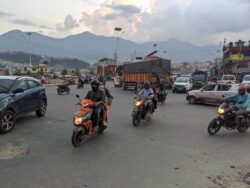Are Traffic Signals Necessary?
American roads perform sub-optimally because they’re over-engineered by government.
Traffic calming measures, as we wrote in our last column, have grown popular recently as a way to improve the pedestrian experience. It’s an article of faith that traffic signs and signals also keep pedestrians (and other transportation modes) safe. Yet there’s growing evidence that they make life more dangerous, while increasing congestion, raising costs, and confusing all parties. It turns out that engineering roads through heavy government involvement just strips away the intuition that drivers would otherwise use.
While this notion may seem absurd, there are multiple examples of how traffic signaling does more harm than good.
Highway safety data show that 40% of American car collisions occur at intersections, reports a study in the Journal of Safety Research. One study from New York City found that installing traffic signals caused a 65% spike in collisions.
Countdown timers—which tell pedestrians how long they have to cross a street and when to stop—particularly fail the safety test, the Journal of Safety Research study found. Where green signal countdown timers have been installed, they “appeared to lead [to] an overall increase in rear-end crash risk at intersections” because drivers would speed up more quickly and brake faster when they perceived that they had the unchallenged right-of-way.
There are a few reasons for this. One is the increased complexity that these signals often cause, making driving more hazardous. Ben Ross writes for Greater Greater Washington that at complex intersections, “demands on the driver’s eye and brain increase, and the inevitable moments of inattention do more harm.” This also applies to the allowance of right turns during red lights at some intersections but not others.
Road design is another issue. U.S. roads are designed for high speeds (unlike European ones, which are older and narrower), and this encourages fast driving.
But another issue is more fundamental, and speaks to why social engineering can have negative consequences. Renowned traffic expert Tom Vanderbilt detailed the experience of Drachten, a Dutch town which all but eliminated signs and signals, instead using street design measures to slow traffic. The transformation was the brainchild of traffic engineer Hans Monderman, who questioned signals because they conditioned the driver to follow the letter of the law rather than make their own observations. Dratchen replaced its traffic signals with roundabouts, for example, as well as installing structures that appeared as physical barriers.
“Monderman envisioned a dual universe,” wrote Vanderbilt. “There was the ‘traffic world’ of the highway, standardized, homogenous, made legible by simple instructions to be read at high speed. And there was the ‘social world,’ where people lived and interacted using human signals, at human speeds.”
Drachten began this transformation in 2002, and while overall traffic increased, car crashes dropped in the same period. A similar redesign was performed on London’s Kensington High Street, leading to fewer collisions.
I saw a more organic, anarchic version of this many times during my 1.5-year trip through the Global South. Here, traffic signals are rarer than in the West. Both pedestrian and automobile traffic are high, with motorbikes and mini-buses regularly weaving around each other and around pedestrians.
Some would argue that this is why traffic fatalities are higher in the Global South. I would counter that there are other factors: poor road quality, older vehicles that don’t have modern safety bulwarks, and the fact that there’s just far more pedestrians walking about.
But on a day-to-day basis, a spontaneous order rises in response to the chaos. Because pedestrians occupy the roads, rather than being physically isolated on sidewalks, drivers are alert to them. And because drivers must negotiate space without the help of timed, sanctioned right-of-way rules, they stay more aware of each other, too, navigating slowly.
I saw an example of this at a crowded intersection in Kathmandu, Nepal. There were no lights or signs, so vehicles from all four directions mosied into the intersection, weaving through space as it freed up. It seemed safer, because vehicles coming from any one direction could not just speed through the intersection, as none of them had a green light. And it was most definitely faster, because cars didn’t have to wait their turns lined up at stop signs or red lights.

Kathmandu and other Global South cities lack these signals because they don’t have the money. But that’s another reason why they shouldn’t exist to the extent they do in U.S. cities. Installing electronic signals can cost in the high-6 figures at intersections, and that doesn’t include maintenance costs. Signals are impractical for many cash-strapped and low-traffic American municipalities, especially if they don’t provide obvious safety benefits.
Traffic signs and signals are yet another case of what happens when central planning and paternalism overtake personal decision making. They in fact eliminate a sense of responsibility, causing people to put faith in abstract processes to guide them. As Vanderbilt concludes: “Traffic signs [are] an invitation to stop thinking, to stop acting on one’s own volition. In streets designed to safely handle the actions of the riskiest participants, everyone slips into riskier behavior.”
This article featured additional research from Market Urbanist content staffer Ethan Finlan.
Cover image available in the public domain.
Catalyst articles by Scott Beyer | Full Biography and Publications
